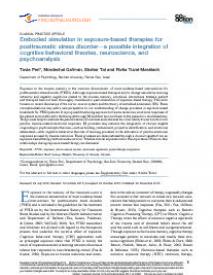Embodied simulation in exposure-based therapies for posttraumatic stress disorder - a possible integration of cognitive behavioral theories, neuroscience, and psychoanalysis
Exposure to the trauma memory is the common denominator of most evidence-based interventions for posttraumatic stress disorder (PTSD). Although exposure-based therapies aim to change associative learning networks and negative cognitions related to the trauma memory, emotional interactions between patient and therapist have not been thoroughly considered in past evaluations of exposure-based therapy. This work focuses on recent discoveries of the mirror-neuron system and the theory of embodied simulation (ES). These conceptualizations may add a new perspective to our understanding of change processes in exposure-based treatments for PTSD patients. It is proposed that during exposure to trauma memories, emotional responses of the patient are transferred to the therapist through ES and then mirrored back to the patient in a modulated way. This process helps to alleviate the patient’s sense of loneliness and enhances his or her ability to exert control over painful, trauma-related emotional responses. ES processes may enhance the integration of clinical insights originating in psychoanalytic theories—such as holding, containment, projective identification, and emotional attunement—with cognitive behavioral theories of learning processes in the alleviation of painful emotional responses aroused by trauma memories. These processes are demonstrated through a clinical vignette from an exposure-based therapy with a trauma survivor. Possible clinical implications for the importance of face-to-face relationships during exposure-based therapy are discussed.
Geachte bezoeker,
De informatie die u nu opvraagt, kan door psychotraumanet niet aan u worden getoond. Dit kan verschillende redenen hebben,
waarvan (bescherming van het) auteursrecht de meeste voorkomende is. Wanneer het mogelijk is om u door te verwijzen naar de bron
van deze informatie, dan ziet u hier onder een link naar die plek.
Als er geen link staat, kunt u contact opnemen met de bibliotheek,
die u verder op weg kan helpen.
Met vriendelijke groet,
Het psychotraumanet-team.
Reference:
Tuvia Peri, Mordechai Gofman, Shahar Tal , & Rivka Tuval-Mashiach | 2015
In: European journal of psychotraumatology, ISSN 2000-8066 | 6 | 29301
http://www.ejpt.net/index.php/ejpt/article/view/29301
In: European journal of psychotraumatology, ISSN 2000-8066 | 6 | 29301
http://www.ejpt.net/index.php/ejpt/article/view/29301


